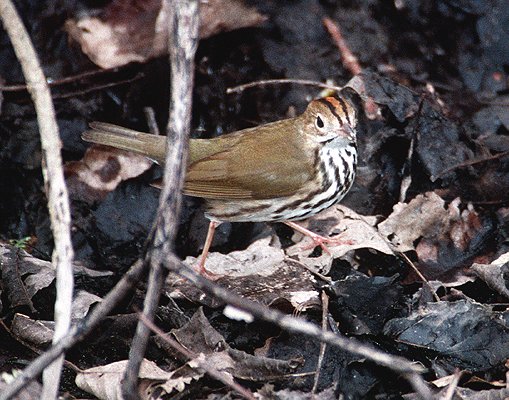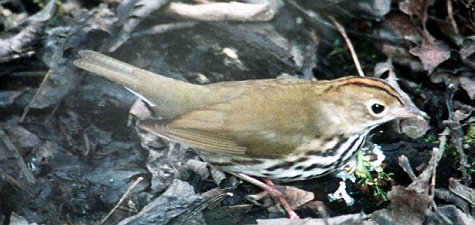|
Ovenbird Seiurus aurocapillus Pizpita Dorada,
|
 |
|
Photo: G. Beaton
|
|
Ovenbird Seiurus aurocapillus Pizpita Dorada,
|
 |
|
Photo: G. Beaton
|
|
IDENTIFICATION: An olive-backed warbler with bold, black streaks on the breast, and an orange, central crown stripe. Length: 15 cm.; weight: 19-21 g. VOICE: Generally silent on the wintering grounds, but on migration and when establishing breeding territories, has a loud, repetitive "teacher" song that is characteristic of northern forests. Audio 2 (M. Oberle). HABITAT: This species is a "generalist" among the migrant warblers. It is found at ground level in mangroves, wetlands and a variety of tropical forests, especially with a well-developed shrub layer; also in plantations of shade-grown coffee. HABITS: The Ovenbird is quite inconspicuous as it walks on the forest floor, searching the leaf litter and occasionally small shrubs for insects, spiders, snails, and other invertebrates. As it inspects fallen tree trunks and flicks over dead leaves, it pumps its tail and sometimes holds it cocked upwards. It often returns to the same winter feeding area each year. On the breeding grounds in North America, the male Ovenbird sings from understory trees, and at twilight will hover above the treetops singing as it patrols its territory. Sometimes neighboring males sing in tandem, with the song of one male starting as the first male finishes. The female builds a dome-shaped nest on the ground in open deciduous woodlands, without any direct help from the male. The nest has an entrance on the side, giving it the appearance of a tiny oven. She lays 4-5 eggs, and does all the incubating for 12-14 days, while the male occasionally feeds her. The female eats the eggshells after the chicks hatch and does all the brooding of the young. However both sexes bring food to the chicks and eat the fecal sacks that the chicks produce. As the chicks get bigger, the adults drop the fecal sacks far from the nest to keep the nest hidden from predators. Young birds fledge 7-10 days after hatching, but are still partially fed by the adults over the following two weeks. If food is abundant, the Ovenbird may have two or even three broods in a season. Birds that winter in the Caribbean are thought to breed east of the Appalachian Mountains. STATUS AND CONSERVATION: A common, but secretive forest species in winter. Its population has declined because of fragmentation of breeding areas in North American forests. Forest fragmentation allows predators and cowbirds easier access to forest birdsí nests. In some places, Brown-headed Cowbirds lay eggs in more than half of all Ovenbird nests, which reduces the nest success of the host bird. Many Ovenbirds also die in collisions with communications towers and buildings during night-time migration. RANGE: Breeds in deciduous forests of southern Canada and the eastern and central USA. It winters through most of Mexico and Central America to northern Venezuela, and from southern Florida through the Bahamas, the Greater Antilles and the Virgin Islands. A regular location to see this species is at Guánica State Forest. TAXONOMY: PASSERIFORMES; PARULIDAE |
|
 |
|
|
Photo: G. Beaton
|
|
References Arendt, W.J. 1992. Status of North American migrant landbirds in the Caribbean region: a summary. Pp. 143-171 in Ecology and conservation of neotropical migrant landbirds (J.M. Hagan III and D.W. Johnston, eds.) Smithsonian Instit. Press, Washington, D.C. Burke, D.M. and E. Nol. 1998. Influence of food abundance, nest-site habitat, and forest fragmentation on breeding Ovenbirds. The Auk 115(1):96-104. Bent, A.C. 1953. Life histories of North American wood warblers. Smithsonian Instit. U.S. National Museum Bull. 203. (Reprinted by Dover Press, NY, 1963). Dunn, J. and K. Garrett. 1997. A field guide to warblers of North America. Houghton Mifflin, NY. Ehrlich, P.R., D.S. Dobkin, and D. Wheye. 1988. The birderís handbook: a field guide to the natural history of North American birds. Simon and Schuster/ Fireside, NY. Faaborg, J. and J.E.Winters. 1980. More returns from the Guánica forest, Puerto Rico. J Field Ornithol. 51(4):368. Faaborg, J. 1982. Avian population fluctuations during drought conditions in Puerto Rico. Wilson Bull. 94(1):20-30. Faaborg, J. and W.J. Arendt. 1984. Population sizes and philopatry of winter resident warblers in Puerto Rico. J. Field Ornithol. 55:376-378. Faaborg, J. and W.J. Arendt. 1992. Long-term declines of winter resident warblers in a Puerto Rican dry forest: which species are in trouble? Pp. 57-63 in Ecology and conservation of neotropical migrant landbirds (J.M. Hagan III and D.W. Johnston, eds.) Smithsonian Instit. Press, Washington, D.C. Mazerolle, D. F. and K. A. Hobson. 2003. Do Ovenbirds (Seiurus aurocapillus) avoid boreal forest edges? A spatiotemproal analysis in an agricultural landscape. Auk 120(1):152-162. Ortega, Y. K. and D. E. Capen. 1999. Effects of forest roads on habitat quality for Ovenbirds in a forested landscape. Auk 116(4):937-946. Raffaele, H.A. 1989. A guide to the birds of Puerto Rico and the Virgin Islands. Princeton. Raffaele, H.A. 1989. Una guía a las aves de Puerto Rico y las Islas Vírgenes. Publishing Resources, Inc., Santurce, PR. Raffaele, H.A., J.W. Wiley, O.H. Garrido, A.R. Keith, and J.I. Raffaele. 1998. Guide to the birds of the West Indies. Princeton. Strong, A. M. 2000. Divergent foraging strategies of two neotropical migrant warblers: implications for winter habitat use. The Auk. 117:381-392. Wunderle, J.M., Jr. and R.B. Waide. 1993. Distribution of overwintering nearctic migrants in the Bahamas and Greater Antilles. Condor 95:904-933. Van Horn, M.A. and T.M. Donovan. 1994. Ovenbird (Seirus aurocapillus). No. 88 in The birds of North America (A. Poole and F. Gill, eds.). Acad. Nat. Sci., Philadelphia, PA, and Am. Ornithol. Union, Washington, D.C. Yahner, R. H., and N. H. Piergallini. 1998. Effects of microsite selection on predation of artificial ground nests. Wilson Bull. 110: 439-442. Next related species in taxonomic order Previous related species in taxonomic order |
|